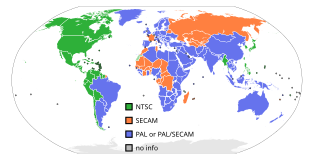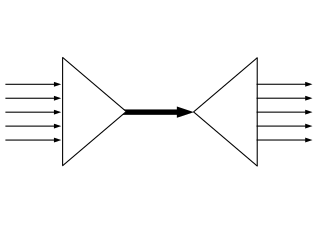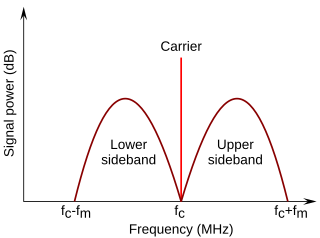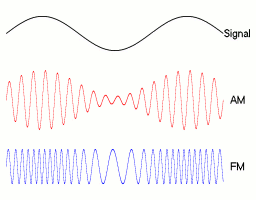Related Research Articles

The first American standard for analog television broadcast was developed by the National Television System Committee (NTSC) in 1941. In 1961, it was assigned the designation System M. It is also known as EIA standard.

In telecommunications, orthogonal frequency-division multiplexing (OFDM) is a type of digital transmission used in digital modulation for encoding digital (binary) data on multiple carrier frequencies. OFDM has developed into a popular scheme for wideband digital communication, used in applications such as digital television and audio broadcasting, DSL internet access, wireless networks, power line networks, and 4G/5G mobile communications.

In telecommunications and computer networking, multiplexing is a method by which multiple analog or digital signals are combined into one signal over a shared medium. The aim is to share a scarce resource – a physical transmission medium. For example, in telecommunications, several telephone calls may be carried using one wire. Multiplexing originated in telegraphy in the 1870s, and is now widely applied in communications. In telephony, George Owen Squier is credited with the development of telephone carrier multiplexing in 1910.

In radio communications, a sideband is a band of frequencies higher than or lower than the carrier frequency, that are the result of the modulation process. The sidebands carry the information transmitted by the radio signal. The sidebands comprise all the spectral components of the modulated signal except the carrier. The signal components above the carrier frequency constitute the upper sideband (USB), and those below the carrier frequency constitute the lower sideband (LSB). All forms of modulation produce sidebands.

In telecommunications, a transponder is a device that, upon receiving a signal, emits a different signal in response. The term is a blend of transmitter and responder.

In telecommunications, frequency-division multiplexing (FDM) is a technique by which the total bandwidth available in a communication medium is divided into a series of non-overlapping frequency bands, each of which is used to carry a separate signal. This allows a single transmission medium such as a microwave radio link, cable or optical fiber to be shared by multiple independent signals. Another use is to carry separate serial bits or segments of a higher rate signal in parallel.
Frequency-division multiple access (FDMA) is a channel access method used in some multiple-access protocols. FDMA allows multiple users to send data through a single communication channel, such as a coaxial cable or microwave beam, by dividing the bandwidth of the channel into separate non-overlapping frequency sub-channels and allocating each sub-channel to a separate user. Users can send data through a subchannel by modulating it on a carrier wave at the subchannel's frequency. It is used in satellite communication systems and telephone trunklines.
In-band on-channel (IBOC) is a hybrid method of transmitting digital radio and analog radio broadcast signals simultaneously on the same frequency. The name refers to the new digital signals being broadcast in the same AM or FM band (in-band), and associated with an existing radio channel (on-channel). By utilizing additional digital subcarriers or sidebands, digital information is "multiplexed" on existing signals, thus avoiding re-allocation of the broadcast bands.
A subcarrier is a sideband of a radio frequency carrier wave, which is modulated to send additional information. Examples include the provision of colour in a black and white television system or the provision of stereo in a monophonic radio broadcast. There is no physical difference between a carrier and a subcarrier; the "sub" implies that it has been derived from a carrier, which has been amplitude modulated by a steady signal and has a constant frequency relation to it.
Digital radio is the use of digital technology to transmit or receive across the radio spectrum. Digital transmission by radio waves includes digital broadcasting, and especially digital audio radio services.
In telecommunications, a pilot signal is a signal, usually a single frequency, transmitted over a communications system for supervisory, control, equalization, continuity, synchronization, or reference purposes.
Single channel per carrier (SCPC) refers to using a single signal at a given frequency and bandwidth. Most often, this is used on broadcast satellites to indicate that radio stations are not multiplexed as subcarriers onto a single video carrier, but instead independently share a transponder. It may also be used on other communications satellites, or occasionally on non-satellite transmissions.

A tuner is a subsystem that receives radio frequency (RF) transmissions, such as FM broadcasting, and converts the selected carrier frequency and its associated bandwidth into a fixed frequency that is suitable for further processing, usually because a lower frequency is used on the output. Broadcast FM/AM transmissions usually feed this intermediate frequency (IF) directly into a demodulator that converts the radio signal into audio-frequency signals that can be fed into an amplifier to drive a loudspeaker.
Datacasting is the broadcasting of data over a wide area via radio waves. It most often refers to supplemental information sent by television stations along with digital terrestrial television (DTT), but may also be applied to digital signals on analog TV or radio. It generally does not apply to data inherent to the medium, such as PSIP data that defines virtual channels for DTT or direct broadcast satellite system, or to things like cable modems or satellite modems, which use a completely separate channel for data.

FM broadcasting is a method of radio broadcasting that uses frequency modulation (FM) of the radio broadcast carrier wave. Invented in 1933 by American engineer Edwin Armstrong, wide-band FM is used worldwide to transmit high-fidelity sound over broadcast radio. FM broadcasting offers higher fidelity—more accurate reproduction of the original program sound—than other broadcasting techniques, such as AM broadcasting. It is also less susceptible to common forms of interference, having less static and popping sounds than are often heard on AM. Therefore, FM is used for most broadcasts of music and general audio. FM radio stations use the very high frequency range of radio frequencies.
Subsidiary Communications Authorization (SCA) in the United States, and Subsidiary Communications Multiplex Operation (SCMO) in Canada, is a subcarrier on a radio station, allowing the station to broadcast additional services as part of its signal.
A communications satellite's transponder is the series of interconnected units that form a communications channel between the receiving and the transmitting antennas.

Radio is the technology of signaling and communicating using radio waves. Radio waves are electromagnetic waves of frequency between 3 hertz (Hz) and 3,000 gigahertz (GHz). They are generated by an electronic device called a transmitter connected to an antenna which radiates the waves, and received by another antenna connected to a radio receiver. Radio is widely used in modern technology, in radio communication, radar, radio navigation, remote control, remote sensing, and other applications.
The Automatic Transmitter Identification System (ATIS) is a communications protocol used for the station identification of television channels carried on satellite television.
The Public Radio Satellite System (PRSS) is the interconnected satellite-distributed network managed by NPR, and used by NPR, Public Radio Exchange (PRX), and American Public Media (APM), as well as independent public radio program producers, to distribute programming via satellite to public radio stations across the United States.
References
- ↑ Beckerdite, Susan (1992). "Satellite Audio". Satellite TV 1992 Buyer's Guide. Fortuna Communications Corp. pp. 70, 72.
- ↑ "4. A Wave of International Standardization (1970–1979) : Chronology". A Quick History of Fujitsu. Archived from the original on 1 April 2010. Retrieved 23 May 2011.
- ↑ Haukap, Anthony W. (15 May 2007). "1.5 MONTEREY SPECIFICATIONS". AWH: Chaparral Monterey Receivers FAQ. Archived from the original on 2 September 2012. Retrieved 23 May 2011.
- ↑ Beckerdite, Susan (1992). "Satellite Audio". Satellite TV 1992 Buyer's Guide. Fortuna Communications Corp. p. 72.
- 1 2 "Universal SCPC-200 page". R.C. Distributing. Retrieved 23 May 2011.
- ↑ Bourgois, Gary (13 February 1996). "Frequently Asked Questions list". rec.video.satellite / HOMESAT-L. Retrieved 23 May 2011.
- ↑ "SpaceCom Upgrades Founding Technology". New York, San Francisco: Business Wire. 5 April 2000. Retrieved 23 May 2011.[ dead link ]
- 1 2 Herbst, Kris (25 June 1990). "Networks that Make Sweet Music". Network World. Vol. 7, no. 26. Framingham, Massachusetts. p. 39. Retrieved 23 May 2011.
- ↑ "Universal Electronics SC-50 receiver page". Universal Radio Inc. Retrieved 23 May 2011.
- ↑ Fine, Thomas (2008). Barry R. Ashpole (ed.). "The Dawn of Commercial Digital Recording" (PDF). ARSC Journal. Ted P. Sheldon. Retrieved 23 May 2011.
- ↑ Herbst, Kris (24 April 1989). "Networking the Networks". Network World. Vol. 6, no. 16. Framingham, Massachusetts: IDG Communications. p. 36. Retrieved 23 May 2011.
- 1 2 3 Sepmeier, Bill (1996). "Satellite Audio Networks...Bits of History". The Technology Interface Journal. No. Winter 1997. Las Cruces, New Mexico: New Mexico State University. Archived from the original on 7 September 2006. Retrieved 23 May 2011.
- ↑ Scherer, Chriss, ed. (1 August 2001). "Sunset on SEDAT". Radio. New York: NewBay Media, LLC. Archived from the original on 15 October 2011. Retrieved 23 May 2011.
- ↑ "Echostar Programs" (PDF). Muzak. Archived from the original (PDF) on 24 March 2012. Retrieved 23 May 2011.
- ↑ "Muzak page". Lyngsat Address. Lyngemark Satellite. Archived from the original on 10 May 2012. Retrieved 23 May 2011.
- ↑ "StarGuide Products". StarGuide Digital Networks, Inc. 2003. Archived from the original on 4 February 2010. Retrieved 23 May 2011.
- ↑ "X-Digital Systems Inc. Acquires Certain Assets of Starguide Digital Networks from DG Fastchannel". X-Digital Systems Inc. Las Vegas, Nevada. 18 April 2007. Archived from the original on 24 March 2012. Retrieved 23 May 2011.
- ↑ "News – Archives page". X-Digital Systems Inc. Archived from the original on 24 March 2012. Retrieved 23 May 2011.